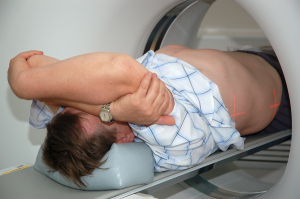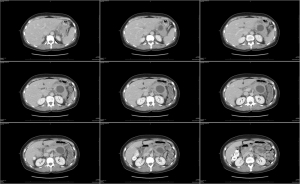Introduction
Diagnostic tests of pancreatic cancer are at present not available. There is no reliable screening test that one could employ similar to the PSA test for prostate cancer.
In other words, for research purposes there are some cell markers such as CA 19-9 and CA 195 , which have more pancreatic cell specificity than CEA or CA 125, but all of these have too many false positives and false negatives to be of use for screening.
Blood tests, CT or MRI scans
However, some of these markers can be used, when they are found to be positive, to follow treatment of a patient and hopefully see these tests turn negative with a positive treatment result.To put it another way, blood tests can be utilized to show that there is indeed an obstructive jaundice. For example, liver function tests will establish whether or not there are liver metastases. CT scans of the abdomen (2 black arrows in the left middle show a cancer of the head of the pancreas) will establish whether or not there is a pancreatic cancer (B= cancer in head of pancreas; A= normal tail of pancreas). As shown in this case, it can be shown before the surgery whether the cancer is in the head or in the tail of the pancreas, which has consequences as to the surgical approach.
Endoscopic retrograde cholangiopancreatography (ERCP)
Endoscopic retrograde cholangiopancreatography (ERCP) is a test where in a first step an endoscope is swallowed by the patient and advanced to the opening of the pancreatic duct in the ampulla of the duodenum. The second step is the advancing of a smaller telescope by the specialist, which probes through this opening (=ampulla of Vater) and injects a radioopaque material into the common bile and main pancreatic duct so that x-rays can be done that show these ducts and the ampulla in relation to the pancreatic mass.
Further tests that are available to the physician are abdominal ultrasound and angiography, where the tumor vessels in relation to the normal vessels can be seen.
Needle aspiration biopsy
Other tests that are useful are fine needle aspiration biopsy of the pancreas and percutaneous (=through the skin) biopsy of liver metastases. The physician does these last two tests under CT scan guidance to ensure that the needle is exactly where it should be when performing the biopsy. With these biopsy tests a tissue diagnosis can be made, which is the only way how cancer can be diagnosed directly. Finally, laparoscopy is a diagnostic test and mini-surgical procedure that is very useful. If the patient has ascites and likely has intraabdominal metastases, then the much easier laparoscopy, a much smaller procedure, can prevent the more invasive laparotomy (Ref. 1 and 2).
References
1. Cancer: Principles &Practice of Oncology.4th edition. Edited by Vincent T. DeVita, Jr. et al. Lippincott, Philadelphia,PA, 1993. Chapter on Cancer of the pancreas.
2. Cancer: Principles&Practice of Oncology. 5th edition, volume 1. Edited by Vincent T. DeVita, Jr. et al. Lippincott-Raven Publ., Philadelphia,PA, 1997. Chapter on Cancer of the pancreas.
3. T Nishihara et al. Jpn J Cancer Res 2000 Aug;91(8):817-824.
4. L Staib et al. Int J Cancer 2001 Apr 1;92(1):79-87.
5. Conn’s Current Therapy 2004, 56th ed., Copyright © 2004 Elsevier
6. Ferri: Ferri’s Clinical Advisor: Instant Diagnosis and Treatment, 2004 ed., Copyright © 2004 Mosby, Inc








